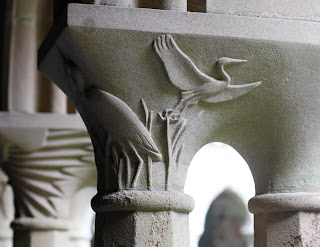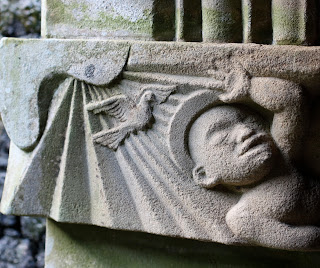I am painting only the briefest of pictures with the lightest of brushes... hopefully, just enough to whet your appetite for seeking out information on your own - or better yet, for visiting Iona yourself!
Most of the islands historical/religious buildings have been restored or rebuilt over a 120 year period, but are laid out much as they would have been in the 1200's.
The ecclesiastical buildings are now all entrusted to Historic Scotland and they maintain the properties, including the Abbey, the Nunnery ruins (above, which are considered to be the finest in the UK) and the cemetery, in which many Princes and Kings of Ireland and the Northern Isles are reputedly buried, including Duncan and MacBeth. (Yes, Shakespeare's, Macbeth!)
My favorite part of the Abbey was the Cloister -
a central court around which monastic communities
organized their domestic quarters.
The covered walkways linked the church
with the domestic buildings
but also served as a place for quiet contemplation
and as part of the processional route
There are only 3 original columns remaining (those on the far left);
the rest were replaced in the 1950's,
although all are showing signs of erosion
given the harsh weather conditions on the island.
The 'new' columns have lovely carvings
celebrating the flora,
fauna and
wild life found on the island.
The corner pillars depict scenes of religious import:
the Nativity,
the parable of the mustard seed,
the Alpha and Omega,
(I love how it seems to emerge from the darkness)
and the Cup of Life.
In the center of the cloister garden is a sculpture called-
The Descent of the Spirit -
which we all agreed was
out of place and totally unnecessary.
There is a duplicate statue in
New Harmony, IN
and somehow it seems far more suited to the
Roofless Church there...
(although amazingly, not one person asked us for our opinion!)
One interesting 'factoid' I picked up on this trip
is that when you see effigies of royalty -
in this case, the Duke of Argyll
and his third wife, Ina,
who initiated the Abbeys restoration
in the late 1800's -
if, like the Duchess, they're wearing their crown,
it means their remains are buried on site.
If there's no crown (see the Duke;
his crown was at his feet),
it indicates his remains are buried elsewhere.
(In his case, interred in family burial grounds
at Kilmun, Argyll.
Now if only THAT was a question
at the next Trivia night I attend,
I could actually use that bit
of arcane knowledge!
What I'm finding from these last few posts
is that I am NOT cut out to be a
travel guide...
truth is
historical dates and facts just don't interest me...
but beauty does,
the experiential reality
of sitting in a dark chapel
that has held the hopes,
dreams, sadness
and petitions
of pilgrims
for centuries
and recognizing myself
as a small part of the throng
who has born witness to the belief
that there's a reality beyond what we know
in this life
and wanting to get closer still
to the One who
created all things;
that does interest me.
Here are other scenes from around the Abbey
that don't need any explanation -
but can be enjoyed best in quiet
and stillness.
Now, O Lord,
calm me into a quietness that heals and listens,
that molds my longings and passions,
my wounds and wonderings
into a more holy, human shape.
In the silence let me listen
and hear the truth you have put into me;
trust the love you have for me
which you call me to live out
with all my sisters and brothers in your human family.
Ted Loder




























No comments:
Post a Comment